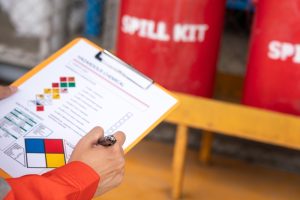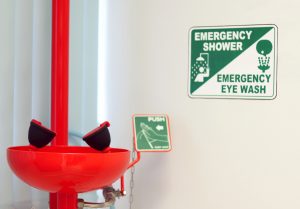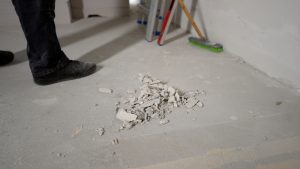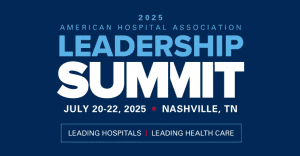June 2025
Inside This Issue

Laboratory Survey Notice:
The June edition of Perspectives is devoid of any new requirements, and the one change announced for laboratories actually simplifies existing practice. Appendix C of the CMS State Operations Manual (SOM) for laboratories permits up to a two-week announcement of a planned routine survey. TJC has announced that they will implement the same practice, permitting up to two weeks’ notice of a routine laboratory survey.
Complaint surveys and follow up visits from previously noncompliant findings will remain unannounced. The Joint Commission (TJC) has one modification to this new announcement practice, and that is if a laboratory survey is being conducted concurrently with another accreditation program that must be unannounced, the laboratory survey will also be unannounced.
The Consistent Interpretation column was not published in the June Perspectives issue.

Incidental Hazardous Chemical Spills:
EC News has an informative article about incidental hazardous chemical spills. There are two basic levels of significance for spills with the first being incidental spills of a small volume that can be contained and cleaned up easily. The second category are major spills that may require the activation of your emergency operations plan and/or a decontamination team or external agency to assist in managing the spill.
Occupational Safety and Health Administration (OSHA) guidance states that incidental spills may be cleaned up by maintenance workers who have the appropriate training and personal protective equipment (PPE). OSHA further defines incidental release as the release of a hazardous substance that does not pose a significant safety or health hazard to employees in the immediate vicinity or the worker cleaning it up, nor does it have the potential to become an emergency.
EC News guides us that OSHA requirements, while important, are not the only agency standards that may be applicable. The Environmental Protection Agency (EPA), Department of Transportation (DOT), and other special guidance documents such as USP Chapter 800, are also important. EC News provides several links to additional resources including one from the American Chemical Society (ACS) designed for laboratories, Guide for Chemical Spill Response. There is also a reference included to a NISOH developed spill guide specific to glutaraldehyde, Glutaraldehyde: Spill Containment and Cleanup.

They also reference the NIOSH Pocket Guide to Chemical Hazards from 2007, but you would need pretty large pockets as this is a very extensive document of 454 pages. You can download the PDF, but they also offer a phone app version that you could carry in a pocket; both are available.
Lastly, this EC News article reminds us of the need for an eyewash station or emergency shower in locations where a worker can be splashed with a corrosive chemical or formaldehyde. This remains a very common deficient finding on survey where the eyewash station does not exist, access is blocked, eyewash is not tested per policy, temperature of the water is not tepid, staff don’t know how to properly activate the eyewash, or the eyewash is placed behind a locked door.
Coping with Physical Environment Staff Shortages:
The June issue of EC News has an article suggesting ways of coping with staff shortages in the physical environment arena. The author points out the difficulty when historical knowledge is lost due to staff retirement, attrition, downsizing, or other reasons. This loss of an individual with historical knowledge is an issue we have seen in many departments, not just in physical environment, when an individual leaves who had what we would call a “person dependent knowledge process.”

These individuals often managed a process for the organization and maintained historical records on their computer that no one else has access to or knowledge about. When that individual leaves, their computer is usually replaced, eliminated, or wiped clean for a new employee, but so too is the data. More importantly, the realization that such records once existed and need to continue, the person dependent knowledge process is often lost as well.
The author focuses on physical environment staffing, but there are many suggestions for managers in other areas and human resources professionals that may prove valuable to share.
Workplace Violence:

EC News has a case study on the Workplace Violence (WPV) initiatives at the Cleveland Clinic which identifies a new piece of legislation, Section 3727.18 Hospital Security Plans, signed by the Ohio Governor that seems to codify workplace violence prevention activities into law that must be in place in every hospital; many of which are similar to The Joint Commission’s standards.
In the remainder of the article, the authors discuss the WPV activities at Cleveland Clinic including the organizational structure, security officer/police functions, and the zero tolerance cultural transformation, along with education of staff on reporting expectations. Your security/safety teams will find this worth reading.
Controlling Construction Dust and Debris:
The last EC News article this month discusses controlling construction dust and debris, which is unfortunately still a frequently cited issue. For many, many years organizations have performed an Infection Control Risk Assessment (ICRA) prior to construction or renovation. But a part of the expectation that is still frequently missed is the examination beyond just infection control issues such as noise and vibration.

We looked back at our old manuals to see when the term “Preconstruction Risk Assessment” (PCRA) first appeared, and we see it in the 2010 standards manual, so it is by no means new. Perhaps a better way to think about this is to develop a PCRA that includes everything including infection control related issues.
The article has a link that is supposed to take you to the Matrix of Precautions for Construction, Renovation and Operations that did not work when we tried it. The top header of which says, “Infection Control Risk Assessment 2.0,” although it contains both infection control and PCRA issues.
There is also a link provided by EC News to another of JCR’s checklist tools for evaluating the content of your preconstruction risk assessment process that looks useful. We would suggest using the link provided in EC News to assess the thoroughness of your existing tool and process as we still see facilities getting stung for not considering potential construction issues outside of the infection prevention area.
 DNV: Healthcare University:
DNV: Healthcare University:
DNV is hosting a 3-day in-person educational program June 24 – June 26 in Atlanta. This training event is offering several different courses that may be of interest. Visit DNV’s Healthcare University 2025 to learn more and register to attend.

Hospital Price Transparency:
Again, this month there are no new QSO memos from CMS. In our April 2025 Patton Post, we had mentioned an article in Becker’s outlining some priorities of the new CMS leadership which included hospital price transparency. This is an issue that stayed on the radar screen from President Trump’s first term to President Biden and now back to President Trump, so it is likely not going away.
We noted that on May 22, 2025, CMS did issue a document entitled Updated Hospital Price Transparency Guidance which details how they expect hospitals to produce and display pricing. As there could be some public embarrassment or fines associated with noncompliance, you will want to keep up with these requirements.
The CMS administrator also sent a letter, Urgent Review of Quality Standards and Gender Transition Procedures, to selected hospitals on May 28th regarding gender transition services. The letter contained a long list of medical procedure codes, and they are requesting financial data from those selected hospitals on those procedures.
CONSULTANT CORNER
 We are saddlin’ our horses and strappin’ our boots for the 2025 American Hospital Association Leadership Summit being held in Nashville, TN next month! Bringing together senior executives, clinicians, and industry experts alike this July 20-22, AHA will present “innovative approaches for delivering better care and greater value, ensuring financial stability, addressing workforce challenges and improving the health care consumer experience through operational excellence, creative partnerships and redefined delivery models.”
We are saddlin’ our horses and strappin’ our boots for the 2025 American Hospital Association Leadership Summit being held in Nashville, TN next month! Bringing together senior executives, clinicians, and industry experts alike this July 20-22, AHA will present “innovative approaches for delivering better care and greater value, ensuring financial stability, addressing workforce challenges and improving the health care consumer experience through operational excellence, creative partnerships and redefined delivery models.”
Our very own Julia Finken, RN, BSN, MBA, CPHQ, LCSSMBB is exhibiting and will hold an exciting and informational booth set up for all attendees to enjoy. We will have some fun and useful giveaways, a tasty treat, and a raffle prize for a random winner at the end!
We’re also excited to share that another one of our very own, John R. Rosing, MHA, FACHE, will be front and center this fall in Anaheim, CA as a workshop speaker at the OR Manager Conference 2025, a premier event for healthcare leaders from across the country. The workshop session will focus on real-world strategies for improving performance, leadership, and regulatory readiness—topics we live and breathe.
Mastering Joint Commission Standards and CMS Regulations:
 Many of the most problematic Joint Commission standards are applicable to the Operating Room and invasive procedural areas of your hospital. Attend this workshop and learn how to identify each of these issues, highlight how surveyors attempt to assess your compliance with them, and share methods to install bullet-proof solutions to ensure a finding-free survey.
Many of the most problematic Joint Commission standards are applicable to the Operating Room and invasive procedural areas of your hospital. Attend this workshop and learn how to identify each of these issues, highlight how surveyors attempt to assess your compliance with them, and share methods to install bullet-proof solutions to ensure a finding-free survey.
Learning Objectives:
- Prepare your operating room and central sterile processing department for survey.
- Advance the safety of care delivery with sustainable process improvements.
- Develop strategies to avoid the most commonly cited regulatory deficiencies.
Please be sure to stop by and say hello to us at both of these events – we enjoy seeing familiar faces in the crowd!
Thank You!
Jennifer Cowel, RN MHSA
JenCowel@PattonHC.com
Kurt Patton, MS RPh
Kurt@PattonHC.com
Julia Finken, RN, BSN, MBA, CPHQ
julia.finken@hbsinc.com
John Rosing, MHA
JohnRosing@PattonHC.com
